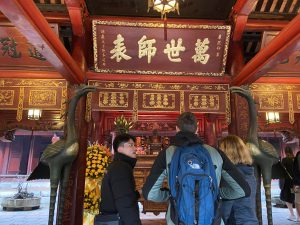Traces of China
Chinese Cultural Influences on Vietnamese Heritage
As neighboring civilizations with deep interwoven histories, Vietnam and China share significant cultural parallels resulting from China’s involvement in Vietnamese development. Through geographical proximity, sociopolitical interactions, and trading ties, Vietnamese traditions adopted influences from Chinese language, architectural principles, religious movements and governance roots with uniquely adapted integration. Despite bloody conflicts marring relationships as well, cultural heritage fusion persists through Vietnam with China’s lingering inspirations.
Shared Language Roots and Script Foundations
Linguistic connections profoundly link Chinese and Vietnamese histories due to colonial rule eras under Chinese governance after 111 BCE when the Han dynasty annexed Vietnam’s Red River delta. Prolonged occupation meant spoken Chinese and invented Chữ Nôm script intermingling with Vietnam’s vernacular dialects, shaping the language foundations still visible today through shared vocabulary.

Modern Vietnamese particularly reflects this heritage fusion through numbering systems, political concepts, agricultural terms and literary expressions originating from Chinese languages. Chữ Nôm too developed from Chinese scripts as a democratized writing system using modified Han ideographs for representing Vietnamese phonetics and vocabulary. Though later replaced by Romanized Quốc Ngữ script, Chữ Nôm systematization and enrichment of written Vietnamese maintains linguistic affiliated with its northern neighbor.
Adapted Architectural Stylings
Chinese inspirations further filter through Vietnam physically by shaping imperial structures, religious buildings, and common homes after architectural styles from early occupying dynasties. Imperial Vietnam capital Huế showcases the vaulted roofs, protective walls and elegant pavilions mirroring neighboring constructs. These features are traces of fengshui in Chinese spirits. From imperial tombs to village shrines, tiered roofs curve along edges across Vietnam amid bold red and gold design motifs still beloved in modern buildings.

Blending of Philosophies Through Religions
Just as Chinese languages and architecture took hold through occupation policy, imported belief systems from Confucian, Taoist and Buddhist practices flowing southwards left cultural markings upon Vietnam’s religious landscape too. Indigenous Vietnamese religion absorbed philosophical infusions from all three Chinese-born ideologies during the first millennium CE. Deified ancestral guardian worship and agricultural customs thereby became imbued with perspectives on morality, heavenly order and karma.
Especially as later dynasties made Confucian civil service exams mandatory for government positions, philosophical thought formally fused into Vietnamese elite culture. Temple complexes like Hanoi’s Temple of Literature also specifically venerate Confucius alongside locally beloved heroes through intricate architecture and spiritual observance. While Vietnam certainly adapted teachings on Vietnamese terms, fingerprints of all three religions persist in evolving belief practices.

Governance and Legal Traditions
Finally, imperial Chinese systems established structures for law, governance and statecraft emulated by independent Vietnamese rulers later on. Legalist royalty principles championed consolidated power and efficient bureaucracy from China’s warring states period, which Le dynasty rulers then championed while expanding territory and codifying strict laws. Later reformists again looked towards China’s centralized governance as reformatory models for reshaping administration after eras of laxity.
Through extensive interactions, China’s development trajectories left defining imprints upon the political and cultural evolution manifesting Vietnamese identity today. Some conflicts bloodily contradicted such cooperation, yet immersive Chinese influences through occupation catalyzed foundational blending for language, architecture, beliefs and rulership now synonymous with heritage. Chinese New Year or Lunar New Year is celebrated in Vietnam as an important holiday. Vietnam thereby honors its distinct national spirit while reflecting subtle shaping from one of history’s greatest civilizations nearby.
If you are in Vietnam and interested in discovering more about Hanoi – the capital and its significance, we invite you to join us at Free Walking Tours Hanoi. We’ll take you across the building, and provide you with a unique perspective of the city. Book now and don’t miss out on this amazing experience.


![]()